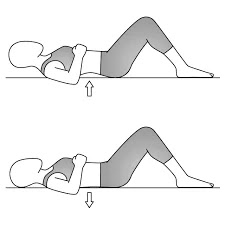What is a Williams Flexion Exercises?
Williams flexion exercises (WFE) — also called Williams lumbar flexion exercises or simply Williams exercises — are a set or system of related physical exercises intended to enhance lumbar flexion, avoid lumbar extension, and strengthen the abdominal and gluteal musculature in an effort to manage low back pain non-surgically. It also stretches the erector spinae, hamstring, and tensor fasciae latae muscles and iliofemoral ligament. The system was first devised in 1937 by Dr. Paul C. Williams, then a Dallas orthopedic surgeon.
History:
The WFEs were developed out of the Regen exercise (also called “squat exercise”), advocated in the 1930s by Eugene M. Regen, a Tennessee orthopedic surgeon, and which consist in squatting and emphasizing the convexity of the lumbar area. Williams first published his own modified exercise program in 1937 for patients with chronic low back pain in response to his clinical observation that the majority of patients who experienced low back pain had degenerative vertebrae secondary to degenerative disk disease. These exercises were initially developed for men under 50 and women under 40 who had exaggerated lumbar lordosis, whose x-ray films showed decreased disc space between lumbar spine segments (L1-S1), and whose symptoms were chronic, but low grade.
RATIONALE :
Williams believed that the basic cause of all low Back pain is the stress induced on the inter-vertebral disc by poor posture. He theorized that the lordotic lumbar spine placed inordinate strain on the posterior elements of the inter-vertebral disc and caused its premature dysfunction. He was concerned about the lack of flexion in daily activities in the accumulation of extension forces that hurt the disc.
Goals of Williams flexion exercise (WFE):
The goals of these exercises are to open the intravertebral foramina and stretch the back extensors, hip flexors, and facets; to strengthen the abdominal and gluteal muscles; and to mobilize the lumbosacral junctions. And also reduce low Back pain and provide lower trunk stability.
Mechanism of Williams lumbar flexion exercises :
Williams said: "The exercises outlined will accomplish a proper balance between the flexor and the extensor groups of postural muscles...". Williams suggested that a posterior pelvic-tilt position was necessary to obtain best results.
Both flexion and extension exercises have been shown to help reduce back pain and has been demonstrated to accomplish the following:
- a) significantly increase the canal area
- b) increase the midsagittal diameter
- c) increase the subarticular sagittal diameter
- d) increase all the foraminal dimensions significantly.
Procedure of Williams lumbar flexion exercises
These exercises were performed in the supine position on a floor or other flat surface. There were variations, but the primary maneuver is to grab the legs and pull the knees up to the chest and hold them there for several seconds. The patient then relaxes, drops the legs down and repeats the exercise again. The primary benefit is supposed to be the opening of the intervertebral foramen, the stretching of ligmentous structures, and the distraction of the apophyseal joints.
Seven of the variations of the Williams lumbar flexion exercises (WFEs) are outlined below :
- Pelvic tilt - Lie on your back with knees bent, feet flat on floor. Flatten the small of your back against the floor, without pushing down with the legs. Hold for 5 to 10 seconds. Pelvic tilt exercises strengthen muscles that support your low back.
- Single Knee to chest - Lie on your back with knees bent and feet flat on the floor. Slowly pull your right knee toward your shoulder and hold 5 to 10 seconds. Lower the knee and repeat with the otherthe other knee.

Knee to chest stretch
- Double knee to chest - Begin as in the previous exercise. After pulling right knee to chest, pull left knee to chest and hold both knees for 5 to 10 seconds. Slowly lower one leg at a time. Knee to chest stretches improve flexibility in your low back.
Double knee chest
- Partial sit-up - Do the pelvic tilt (exercise 1) and, while holding this position, slowly curl your head and shoulders off the floor. Hold briefly. Return slowly to the starting position. Partial sit-ups strengthen the upper and lower abdominal muscles at the same time.
- Hamstring stretch - Start in long sitting with toes directed toward the ceiling and knees fully extended. Slowly lower the trunk forward over the legs, keeping knees extended, arms outstretched over the legs, and eyes focus ahead. The hamstring stretch improves flexibility of the muscles along the back of your thighs.

hamstring stretch
- Hip Flexor stretch - Place one foot in front of the other with the left (front) knee flexed and the right (back) knee held rigidly straight. Flex forward through the trunk until the left knee contacts the axillary fold (arm pit region). Repeat with right leg forward and left leg back. The hip flexor muscles are located at the front of your hips. These muscles are often tight, particularly if you sit a lot during the day. It improves hip flexibility.

Hip Flexor Stretch
- Squat - Stand with both feet parallel, about shoulder's width apart. Attempting to maintain the trunk as perpendicular as possible to the floor, eyes focused ahead, and feet flat on the floor, the subject slowly lowers his body by flexing his knees. The squat exercise strengthens muscles in your hips. Perform this exercise near a sturdy surface if you have difficulty with your balance.

Squat



No comments:
Post a Comment